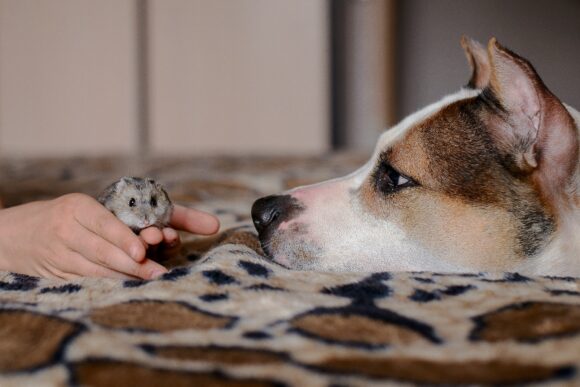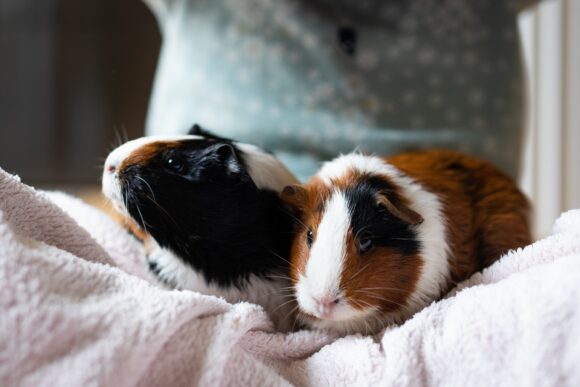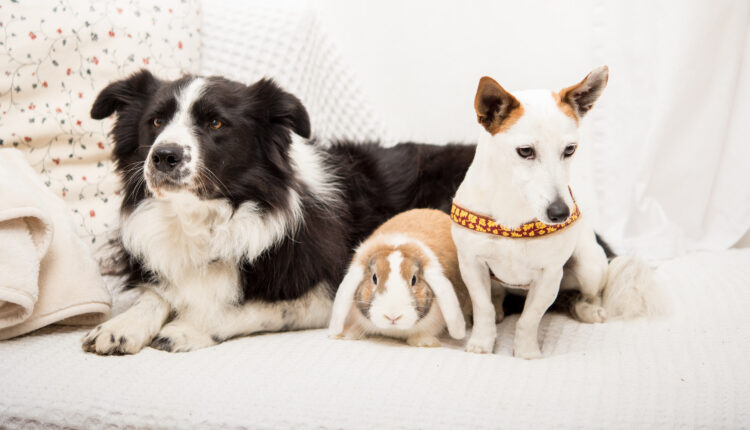What’s The Best Approach For Introducing A Dog To A New Small Pet Like A Hamster Or Rabbit?
If you’re considering adding a new small pet, like a hamster or rabbit, to your household that already has a dog, it’s important to approach the introduction with caution and care. In this article, you’ll learn some tips and best practices for introducing a dog to a new small pet in a way that ensures the safety and comfort of all animals involved.
Firstly, it’s crucial to start with proper preparations before the actual introduction. This includes creating a safe, secure space for the small pet where the dog cannot access it unsupervised. Additionally, it’s essential to provide enough time for both animals to get accustomed to each other’s scent before any face-to-face interactions occur. By taking these precautions, you’ll be setting the stage for a more successful and stress-free introduction process.

Introduction
Introducing a dog to a new small pet like a hamster or rabbit requires careful planning and implementation to ensure the safety and well-being of both animals. Dogs possess natural predatory instincts and prey drive, making it essential to take the necessary steps to create a harmonious living environment for all. In this article, we will discuss the best approach to successfully introduce a dog to a new small pet, focusing on understanding the dog’s nature, preparing the environment, gradual introductions, positive associations, monitoring and supervision, and gradual integration.
Understanding the Dog’s Nature
Before introducing a dog to a small pet, it is crucial to understand the dog’s temperament and prey drive. Every dog has a unique personality, and certain breeds may have different instincts and behavior patterns compared to others. By understanding these aspects, you can better anticipate potential challenges and plan accordingly.
Identifying the Dog’s Temperament
Some dogs naturally have a higher prey drive than others. Retrievers and terriers, for example, are usually bred for hunting and may have a stronger instinct to chase and catch small animals. On the other hand, certain breeds, like toy dogs or herding breeds, may have a lower prey drive. It is essential to consider your dog’s breed characteristics and individual temperament before proceeding with introductions.
Understanding the Dog’s Prey Drive
Prey drive refers to a dog’s instinctual motivation to pursue and capture prey. It varies from dog to dog and can be influenced by various factors, such as breed, training, and previous experiences. Dogs with a high prey drive may become overly excited when spotting small, fast-moving creatures like hamsters or rabbits. Being aware of your dog’s prey drive will help you devise strategies to manage interactions between your dog and the small pet effectively.
Preparing the Environment
Creating a suitable environment is crucial when introducing a dog to a new small pet. By setting up separate spaces and dog-proofing the living area, you ensure the safety of both animals and provide them with their own designated areas.
Creating Separate Spaces for the Dog and the Small Pet
It is essential to establish separate spaces for the dog and the small pet, especially during the initial stages of introduction. This allows each animal to have a secure and comfortable area where they can retreat and feel safe. Consider using baby gates or pet pens to create boundaries and prevent unsupervised interactions between the two animals.
Dog-Proofing the Living Area
Dog-proofing the living area is vital to prevent any accidental or unwanted interactions. Make sure that the small pet’s habitat is securely placed, out of reach from the dog. Store any potentially harmful items, such as cleaning chemicals or small objects, in secure cabinets or drawers. By providing a safe environment for both animals, you minimize the risk of any accidents or conflicts.
Scent Introduction
Gradual scent introduction is a crucial step in the process of introducing a dog to a new small pet. By familiarizing your dog with the scent of the small pet, you help them become more accustomed to their presence.
Exchanging Bedding or Toys
One effective way to introduce scents is by exchanging bedding or toys between the dog and the small pet. This process allows them to become familiar with each other’s smell without direct contact. Place an item with the small pet’s scent near the dog’s resting area and vice versa. This exchange will help your dog associate the scent with something positive, forming a connection and reducing novelty.
Gradual Scent Exposure
Once the initial scent exchange has taken place, gradually increase the exposure between the dog and the small pet’s scents. Allow your dog to explore the area around the small pet’s habitat while supervised. This exposure will help your dog become more comfortable with the scent and recognize it as a part of their environment. Repeat this process over several days until your dog shows no signs of anxiety or aggression in response to the scent.

Visual Introduction
Once your dog is accustomed to the scent of the small pet, it’s time to proceed with visual introductions. This step allows the animals to see each other without direct physical contact, ensuring a gradual and controlled interaction.
Using a Barrier or Pet Gate
To initiate visual introductions, set up a barrier or pet gate between the dog and the small pet. This barrier can be a transparent or sturdy structure that allows both animals to see each other without physical contact. This controlled observation allows the dog to become familiar with the small pet’s appearance while providing a sense of security for both animals.
Allowing Supervised Visual Contact
Under close supervision, allow the dog and the small pet to have visual contact for short periods every day. Observe their reactions closely. If your dog shows signs of aggression or excessive excitement, redirect their attention to a positive stimulus, such as treats or toys. Gradually increase the duration of visual contact over time, ensuring that both animals remain calm and comfortable throughout the process.
Positive Associations
Creating positive associations between the dog and the small pet is essential for fostering a harmonious relationship. By pairing the presence of the small pet with positive experiences, you can help your dog associate them with something pleasant rather than a potential prey.
Using Treats and Rewards
Reward-based training is a powerful tool in creating positive associations. Whenever your dog shows calm and relaxed behavior in the presence of the small pet, provide treats or rewards to reinforce this positive behavior. This positive reinforcement helps your dog associate the small pet’s presence with something enjoyable, reducing the likelihood of aggressive or prey-related behaviors.
Pairing the Presence of the Small Pet with Positive Experiences
In addition to treats and rewards, engage in activities that your dog enjoys while the small pet is nearby. This can include playing with toys, going for walks, or indulging in positive interactions with you. By pairing the presence of the small pet with these positive experiences, you reinforce the idea that their presence brings about enjoyable moments for your dog.

Gradual Physical Interaction
Once your dog has shown positive behavior during visual introductions, it’s time to progress to gradual physical interactions. These interactions should be supervised and controlled to ensure the safety of both animals.
Introducing the Pets with a Barrier In Between
Start by allowing your dog and the small pet to be in the same room with a barrier separating them. This can be a pet gate or a crate that provides a physical barrier while allowing visual contact. This gradual introduction allows both animals to become more familiar with each other’s presence without the risk of direct physical contact.
Progressing to Brief Supervised Interactions
As the animals become more comfortable with each other’s presence, progress to brief supervised interactions with the barrier removed. Keep these initial interactions short and closely monitor their behavior. Look for signs of discomfort, stress, or aggression from either animal. If any signs of tension arise, separate them immediately and provide a positive distraction for your dog. Gradually increase the duration of these interactions over time, ensuring that both animals remain relaxed and at ease.
Monitoring and Supervision
Throughout the entire introduction process, monitoring and supervision are crucial to ensure the safety and well-being of both the dog and the small pet.
Keeping an Eye on Their Behavior
Monitor the behavior of both animals closely during and after interactions. Look for any signs of stress, fear, aggression, or excessive excitement. If you notice any concerning behaviors, such as growling, barking, or lunging, separate the animals and seek guidance from a professional dog trainer or behaviorist. It’s important to address any issues promptly to prevent potential harm to either animal.
Preventing Any Signs of Aggression or Stress
It’s essential to create an atmosphere that minimizes stress and potential aggression. Avoid forcing interactions between the animals if they show signs of discomfort or distress. Provide them with separate spaces and gradually increase their exposure to each other only when both animals exhibit signs of calmness and curiosity. Patience and careful observation are key in preventing any signs of aggression or stress during the introduction process.

Gradual Integration
As positive interactions between the dog and the small pet increase, you can begin to gradually integrate them into each other’s lives. This process should be done gradually and at a pace that is comfortable for both animals.
Increasing the Duration of Supervised Interactions
As the dog and the small pet grow more comfortable with each other, increase the duration of supervised interactions. Allow them to spend more time together in controlled and supervised situations. Observe their behavior closely and be prepared to intervene if necessary. Gradually extended periods of positive and peaceful interaction create opportunities for the animals to further develop a bond.
Allowing More Opportunities for Socialization
Once the dog and the small pet have shown positive interactions consistently over an extended period, you can gradually increase their opportunities for socialization. This can include supervised playtime together or allowing them to coexist in the same space under your watchful eye. Each interaction provides an opportunity for them to develop a relationship and establish boundaries.
Conclusion
Introducing a dog to a new small pet like a hamster or rabbit requires careful planning, patience, and supervision. By understanding the dog’s nature, preparing the environment, gradually introducing scents and visuals, creating positive associations, and monitoring interactions, we can ensure the safety and well-being of both animals. Remember to take the process at a pace that is comfortable for both the dog and the small pet, and seek professional guidance if any concerning behaviors arise. With time and proper introductions, a harmonious relationship can be established between your dog and the new small pet, bringing joy and companionship to both.


